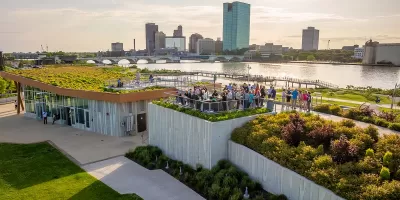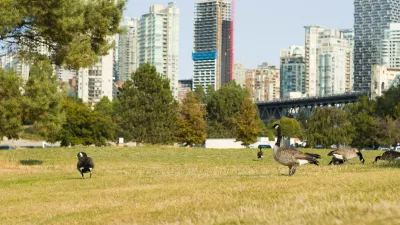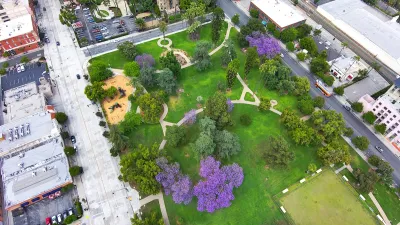How Toledo is transforming its waterfront into a beloved community space.

The community debated for decades about how to transform former industrial sites on Toledo, Ohio’s expansive riverfront from blighted relics of the past into assets for the future. Several times, developers announced plans that never progressed beyond ceremonial groundbreakings. These false starts left behind a road lined with decorative lampposts that some hoped would lead to a reimagined waterfront and others derided as “the road to nowhere.”
In the last six years, however, debate has given way to collaboration in the Glass City, which earned its nickname from a storied past of glass innovation and manufacturing. Today, where a mothballed power plant once stood, a park with unique amenities is creating a new kind of energy, sparking public and private investments beside the largest river flowing into the Great Lakes.
The award-winning Glass City Metropark is only the beginning. The Glass City Riverwalk will stretch beyond the park with a five-mile multi-purpose path – two and a half miles on each side of the Maumee River – connecting neighborhoods, corporate campuses, and entertainment destinations.
This chapter in Toledo's history began in 2017 when ProMedica, a regional healthcare provider headquartered downtown, had the opportunity to acquire the largest tract of open space on the riverfront. ProMedica then approached Metroparks Toledo, a public park system that is independent from other government entities, about buying and renovating the majority of the property. The primary objective was to accomplish one of the goals of a new downtown master plan: increasing green space from 30 to 300 acres to create a more inviting, livable community.
A Columbus developer who first unveiled plans for the riverfront more than 20 years earlier acquired another portion of the property. Metroparks spent less than $10 million in the first phase of park development, which included a glass-enclosed pavilion, event lawn, sledding hill, and walking paths. The developer invested $50 million to build an adjacent, upscale apartment complex and restaurant. When the projects were jointly announced, Frank Kass, chairman of Continental Real Estate Companies, said, “What makes it work for us is Metroparks.”
The rest of Glass City Metropark – about 25 percent of the total Riverwalk footprint – opened on June 9, 2023 with unique-to-the-region outdoor recreation facilities, gathering spaces, and natural areas.
“Our goal is to create the nation’s best riverfront because Toledo deserves it,” said Dave Zenk, executive director of Metroparks Toledo, which operates 19 parks totaling 13,000 acres in Lucas County. “In addition to the amenities we are bringing to the downtown area, we look for more private developments like we have already seen, making the city center more dynamic, creating opportunities and delivering a return on investment to our taxpayers.”
Those taxpayers voted in 2020 to approve a 10-year property tax levy to fund a portion of the cost for Riverwalk, while Metroparks is raising more than half the funding for the $250 million project from other sources, including grants and philanthropic contributions. For example, a Better Utilizing Investments to Leverage Development (BUILD) grant from the U.S. Department of Transportation is partially funding portions of Riverwalk now under construction. When completed, that will wrap up about 50 percent of the 10-year project. Construction on another major stretch of Riverwalk through the city’s oldest neighborhood will begin in 2026, partly paid for with $19 million from the same federal source, now called the Rebuilding American Infrastructure with Sustainability and Equity, or RAISE, Discretionary Grant program.

A promising start
In its first year of full operation, Glass City Metropark saw nearly 800,000 visits. The Ribbon, a 1,000-foot-long skating trail that is a centerpiece of the park, drew 50,000 ice skaters in its first winter.
The Ribbon is the region’s first outdoor winter recreation destination and includes a sledding hill, fire pits, and five reservable huts called Cabanas. Other unique features engage people in four-season outdoor activities, surrounded by a natural setting of 17 acres of trees (10,000 have been planted so far), a 27-acre prairie, and more than 3,200 linear feet of improved shoreline. Those features include:
- Market Hall, a 9,500-square-foot building that houses a quick-casual restaurant, beer garden, restrooms, lockers, event space, and a concession area where ice skates and roller skates are available for rent.
- The Grosbeak Discovery Play Tower, which stands 40 feet tall and is packed with as many play features as could be safely incorporated.
- A Prairie + Pollinator Discovery Play playground inspired by the flora and fauna of the region.
- The Mini-Maumee, a water playscape designed as a replica of the Maumee River watershed.
- The Cove, a former commercial marina redesigned as a naturalized, protected area to enjoy kayaking. Visitors can rent kayaks using a smartphone app, similar to a bike share system. The cove is enclosed by a boardwalk with a series of elevated decks and overlooks connected by rope bridges.
- Public art that interprets the natural and cultural attributes of the riverfront, from glass sculptures to murals painted on the embankments of a bike and pedestrian bridge.
- Three miles of multi-purpose trails inside the park.
- The Pavilion, event lawn and sledding hill that were part of phase 1 development.

The Pavilion, enclosed by glass on three sides with rooftop decks and a “green” overhang planted with native vegetation, quickly became the park system’s most popular rental facility. The building has been the venue for everything from the Toledo mayor’s State of the City address to a nationally televised news conference to announce a heavyweight boxing match. The adjacent event lawn hosts an annual Glass City Jazz Festival and fireworks viewing on the Fourth of July. An existing marina was incorporated into the park, and Metroparks is designing a maritime-themed urban campground slated for construction in 2026 adjacent to the park’s neighbor, the National Museum of the Great Lakes.
On Oct. 9, Glass City received an Innovation Award for Park Design and the overall Best in Innovation (best-in-show) award from the National Park and Recreation Association. In January, the park received a first-place award for park development and a Governor’s Award (best-of-show) from the Ohio Parks and Recreation Association.
Recognition for the park system and other honors awarded to SmithGroup, which designed the park, help raise awareness of Toledo’s quality of life, which has been one of the goals of the development from the start, Zenk said. The director recalled a comment by a guest soon after Glass City opened: “This feels like something you'd find in a big city.” As gratifying as that was to hear, he said, “I couldn't help thinking to myself, ‘You haven't seen anything yet.’”
Planning for the park and Riverwalk began with benchmarking riverfront developments in Tulsa, Oklahoma; Des Moines, Iowa; Chicago, Grand Rapids, Michigan; Louisville, Kentucky and elsewhere. It became apparent that reviving the Toledo waterfront would require unique attractions, such as The Ribbon and the Grosbeak Tower. Public meetings fleshed out other ideas, leading to the children’s water play area, additional transient boat docks, and more fishing access points.

Project Givens kept the design process on track, allowing developers to deliver on promises made to the community:
- Enhance environmental features, prioritize reforestation, improve water quality and adhere to the agency’s 80/20 goal – 80 percent conservation, 20 percent development.
- Honor the values and expectations expressed by the community.
- Incorporate local, state and national trends in recreation and accessibility.
- Connect the community to its waterfront.
- Advance regional connectivity.
An example of innovation in the construction of the park involved the very soil on which it was built. Once the site of a coal-fired power plant, the brownfield had a thin layer of topsoil over fill and fly ash. Getting plants to grow proved challenging. Working with the Toledo Lucas County Port Authority, Metroparks used sediment dredged from the adjacent river as fertile soil across much of the park property.
The Maumee River stretches more than 100 miles from the Indiana-Ohio border to Lake Erie, cutting through thousands of acres of farmland. Fertilized soil runoff from agricultural fields necessitates dredging the river to maintain a shipping channel, and the sediment contributes to the growth of algae in the lake. Making use of the dredge material in the park helped promote sustainable vegetation while providing a beneficial reuse of the waste material.
Still to come
Glass City Riverwalk, which is developing in phases with an estimated completion date of 2030, will accomplish more than 200 of the 300 acres of additional green space called for in the downtown master plan. It will also reconnect neighborhoods historically divided from the river and from each other.
“One of the special aspects of Glass City Riverwalk, to me, is connecting neighborhoods to the water. Some residents have lived near the river their whole lives but were not able to utilize it,” said Jennifer Van Horn, chief planning and construction officer for Metroparks Toledo.
Portions of Riverwalk currently under construction or in design include a spiraling ramp behind the city’s tallest skyscraper that will connect Riverwalk pedestrians and cyclists with one of the three bridges associated with the project. The Martin Luther King, Jr. Bridge, which is currently under construction to add bike and pedestrian lanes, is in the center of the Riverwalk footprint and will be the primary connection between the two sides of the river.
“The Maumee River has been a barrier for generations in Toledo,” Van Horn said. “Riverwalk will connect Toledo and bridge that barrier.”
Also in progress are renovations to a former city park that will be an addition to Glass City Metropark, which will stretch the entire length of the city’s East Side riverfront. The downtown side of the project will connect existing parks, the corporate campuses of ProMedica and Owens Corning, a science museum, concert and sports venues, hotels, and restaurants.
Across the river, Metroparks is white-boxing a metal building that formerly housed city maintenance functions. Inside, private investors are building a family recreation destination including a restaurant, pickleball courts, climbing walls, stages for musical artists, and other features. The facility will be the first of its kind in the region and open late this year.
Unique gathering spaces and playful elements, such as a hammock “village,” a tugboat converted to a cabin for overnight stays, and a lighthouse with artistic lighting and a slide, will encourage family outings and discovery play throughout the Riverwalk.
“This project has been so impactful because it is being done collaboratively with residents, business leaders, Toledo’s mayor and city council, as well as county, state and federal government agencies,” Zenk said. “Together, we are turning negatives into positives, bringing people together for a common purpose and accomplishing what so many have dreamed of for so long – a riverfront we can be proud of.”
Scott Carpenter is director of public relations for Metroparks Toledo. Before joining the park system, he was a journalist and frequently wrote about the Maumee riverfront and other urban planning and natural resources topics in the Western Lake Erie region.

Alabama: Trump Terminates Settlements for Black Communities Harmed By Raw Sewage
Trump deemed the landmark civil rights agreement “illegal DEI and environmental justice policy.”

Planetizen Federal Action Tracker
A weekly monitor of how Trump’s orders and actions are impacting planners and planning in America.

The 120 Year Old Tiny Home Villages That Sheltered San Francisco’s Earthquake Refugees
More than a century ago, San Francisco mobilized to house thousands of residents displaced by the 1906 earthquake. Could their strategy offer a model for the present?

LA’s Tree Emergency Goes Beyond Vandalism
After a vandal destroyed dozens of downtown LA trees, Mayor Karen Bass vowed to replace them. Days later, she slashed the city’s tree budget.

Sacramento Leads Nation With Bus-Mounted Bike Lane Enforcement Cameras
The city is the first to use its bus-mounted traffic enforcement system to cite drivers who park or drive in bike lanes.

Seattle Voters Approve Social Housing Referendum
Voters approved a corporate tax to fund the city’s housing authority despite an opposition campaign funded by Amazon and Microsoft.
Urban Design for Planners 1: Software Tools
This six-course series explores essential urban design concepts using open source software and equips planners with the tools they need to participate fully in the urban design process.
Planning for Universal Design
Learn the tools for implementing Universal Design in planning regulations.
Ada County Highway District
Clanton & Associates, Inc.
Jessamine County Fiscal Court
Institute for Housing and Urban Development Studies (IHS)
City of Grandview
Harvard GSD Executive Education
Toledo-Lucas County Plan Commissions
Salt Lake City
NYU Wagner Graduate School of Public Service





























